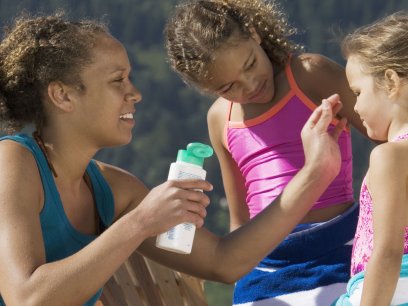
If you grew up playing outside until you were called home for dinner, you might not recognize the “play landscape” of today’s kids. Why? They’ve largely moved indoors. In fact, the average American child spends only four to seven minutes a day playing outside in unstructured activities. At the same time, they spend more than seven hours of screen time a day, whether that’s watching TV, playing video games, texting friends, or surfing the Internet.
Since October is Children’s Health Month, you’ve got the perfect opportunity to not only get your kids (or your friend’s kids, or the neighbor’s kids, or other kids in your life) outside, but to join them! Playing outdoors offers a great way to burn off physical energy. Studies show that spending time in nature can positively impact your mental and physical health, no matter what your age. Here’s how:
- Playing outdoors boosts fitness levels and builds active, healthy bodies—a key strategy in helping the one in five American kids who are obese get fit.
- People who participate in outside physical activity in natural environments are more likely to stick to a future routine than those who exercised at the gym.
- Spending time in nature relaxes you. In fact, it only takes a few minutes to feel its calming effects, as children’s stress levels fall within minutes of looking at green spaces. This can provide an effective approach to reducing ADHD symptoms by helping kids focus better.
- Being outdoors also increases your Vitamin D levels, which helps protect children from future bone issues, heart disease, diabetes, and other health problems.
- Turns out, nature even makes you nicer! Spending time outdoors enhances social interactions, value for community, and close relationships.
Need some ideas to enjoy the great green outdoors? Spend a day at the zoo, go to the beach, or visit your local park. Go for a hike, take a ride on a bike trail, or go kayaking. Go camping, boating, or looking at the fall foliage on a nearby nature trail. Looking for something different? Go rock climbing, explore caves, or try birdwatching. Nature’s playground provides endless opportunities to burn up some energy and improve your mental and physical health. So, get out there and get moving!
To learn more about environmental health activities appropriate for Children’s Health Month, check out this month-long calendar of ideas. Find additional resources from the Environmental Protection Agency about protecting children’s health at home and at school.
Sources:
- American Academy of Pediatrics. “Many Children have suboptimal Vitamin D Levels,” Pediatrics. October 26, 2009. http://www.aap.org/advocacy/releases/oct2609studies.htm
- CDC's National Center for Chronic Disease Prevention and Health Promotion. Division of Adolescent and School Health. Childhood Obesity. 20 Oct. 2008.
- Hofferth, Sandra and John Sandberg (1999), “Changes in American Children’s Time, 1981-1997,” University of Michigan Institute for Social Research.
- Juster, F. Thomas et al. (2004). “Changing Times of American Youth: 1981-2003,” Institute for Social Research, University of Michigan. http://www.umich.edu/news/Releases/2004/Nov04/ teen_time_report.pdf
- Kuo, PhD, Frances E., and Andrea Faber Taylor, PhD. "A Potential Natural Treatment for AttentionDeficit/Hyperactivity Disorder: Evidence From a National Study." American Journal of Public Health 94.9. Sept. 2004.
- Rideout, Victoria et al. (2010). “Generation M: Media in the Lives of 8-18 Year-Olds,” The Henry J. Kaiser Family Foundation. http://www.kff.org/entmedia/entmedia030905pkg.cfm
- Weinstein, N., Przybylski, A. K., & Ryan, R. M. (2009). “Can nature make us more caring? Effects of immersion in nature on intrinsic aspirations and generosity.” Personality and Social Psychology Bulletin, 35, 1315-1329.
- Wells, N.M. (2000). At home with nature: Effects of “greenness” on children’s cognitive functioning. Environment and Behavior (32), 6, pp 775-795.


